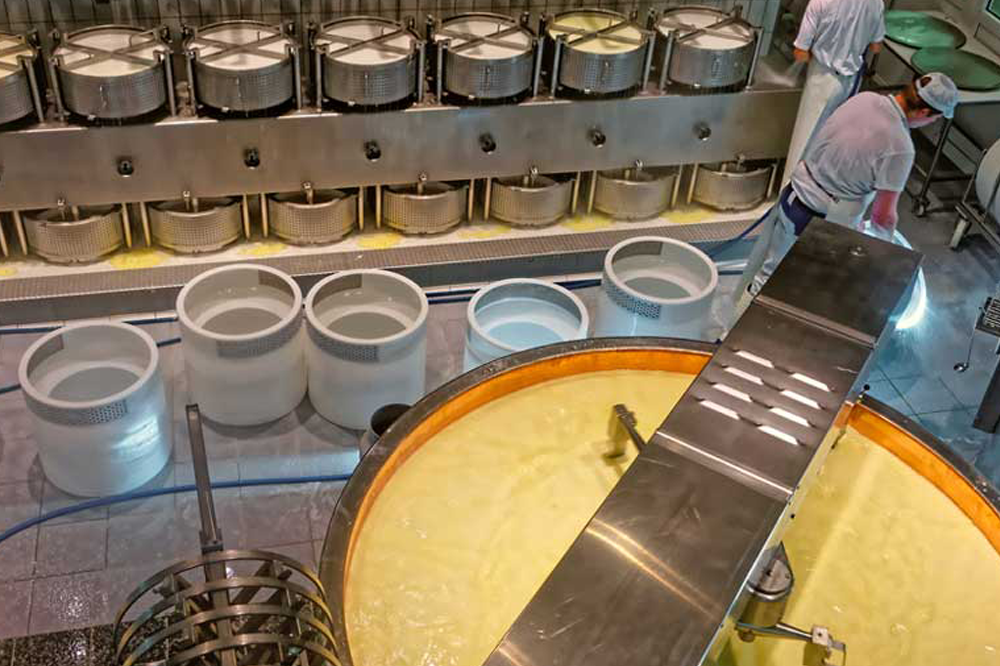One of the sectors of dairy technology in which Condor, a leader in stainless steel processing, has strongly developed, enhancing the mechanization of activities, is the one of tools for milk coagulation and curd processing.
Thanks to our Condor multipurpose milk machines, created for the thermal transformation of milk, from 4 ° C to 100 ° C, into dairy products, yogurt, ricotta, aged, robiole, stracchino, erborinati, caciotte, spreads and much more can be produced. If the varieties of cheese are numerous, the cheesemaking principle is common to the various types and Includes the following processing steps:
-
Milk preparation (with analysis and pasteurization)
-
Clotting (with rennet and ferments)
-
Breakage of curd (with thorn or lyre)
-
Cooking is cooking
-
Curd extraction of curd
-
Fit-in shape
-
Salagion
-
Mature
Let's analyze the individual cycles for cheese production:
Milk preparation
In the first phase of cheesemaking the milk is filtered and pasteurized, for example using our own electric pasteurizer, except of course for the preparation of raw milk cheeses such as Parmigiano Reggiano. To obtain the right fat content, milk is skimmed, while to have a higher lipid content it is added with cream.
Coagulation
In the second phase, ferments are added to the milk, different depending on the type of cheese, and a coagulant of microbial, animal or vegetable origin. The coagulant will promote the formation of curd, a gelatinous mass formed by a three-dimensional lattice in whose mesh fat blood cells, serum, and caseins are trapped.
Breaking the curd
As soon as the curd has obtained the desired consistency, it is broken with special tools. The finer the cut, the more whey will be eliminated, so the harder the final consistency of the cheese will be. So to obtain semi-hard cheeses it is necessary to break the curd into small grains.
Cooking
Depending on the type of cheese, the curd is heated to a temperature ranging from 38 to 60 degrees, from which cooked and semi-cooked cheeses are produced, and for a time ranging from 15 to 90 minutes. Raw cheese doesn’t undergo any kind of heating.
Extracting curd
The curd must be extracted from the whey and placed in the molds or bands typical of the cheese that is produced. This is how the whey purge continues, helped by pressing that also gives the cheese its typical compactness.
Putting in shape
The cheesemaker then fills the molds with the cube curd, followed by dripping and pressing.
Salting
After the shape phase, the cheese is salted by immersion in brine, a mixture of water and salt, or by dry salting, which consists of smearing the cheese with salt to promote penetration. The salt content of cheeses ranges from 0 to less than 1% for very sweet cheeses, such as mozzarella, and to be consumed fresh, from 1 to 2.5% for most common cheeses, from 4 to 6% for tastier ones such as Pecorino Romano.
Maturation or curing
In the last stages of production the cheese can finally rest. During maturation in the cellar the shapes are regularly turned over and, depending on the type of cheese, rubbed, washed or treated with mold. It is precisely during this period of processing and aging, which can last up to 12 months or more, that the cheese develops its specific characteristic features.
Milk processing has undergone rapid evolution in recent years, with the transition from simple milk buckets, aluminum milk containers, milk tanks, copper boilers for dairies to multipurpose dairy machines. With the hope of always offering you maximum help and multiplying your earnings, we remind you that our Condor multipurpose for milk is an extraordinary, high-performance machine, built entirely of AISI 304L stainless steel, with electropolishing performed both internally and externally.





